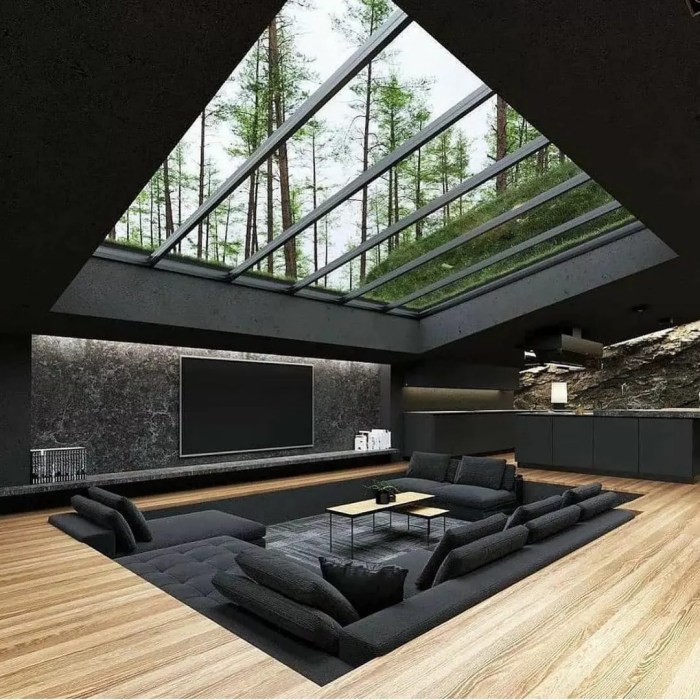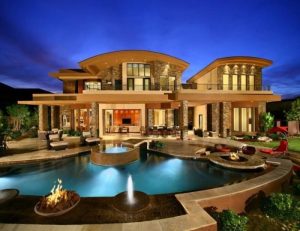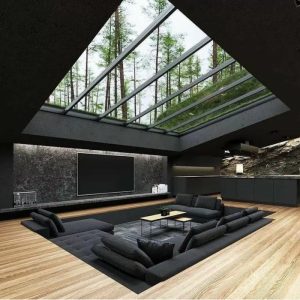
Delving into Modern home remodeling styles, this introduction immerses readers in a unique and compelling narrative, with a focus on the key characteristics, color schemes, interior design elements, and outdoor spaces that define modern home renovations. Explore the latest trends and materials used, as well as tips for seamlessly incorporating technology into your modern home design.
Modern Home Remodeling Styles
Modern home remodeling styles are characterized by clean lines, minimalist design, and a focus on functionality. These styles often incorporate the use of modern materials such as glass, steel, and concrete to create a sleek and contemporary look.
Key Characteristics of Modern Home Remodeling Styles
- Open floor plans that create a sense of spaciousness and flow between rooms.
- Use of neutral color palettes with occasional pops of bold color for contrast.
- Integration of natural elements such as wood and stone for texture and warmth.
- Emphasis on natural light through large windows and skylights.
- Incorporation of smart home technology for convenience and energy efficiency.
Popular Modern Home Remodeling Trends
- Minimalist kitchens with sleek cabinetry, hidden appliances, and integrated storage solutions.
- Luxurious bathrooms with spa-like features such as rain showers, soaking tubs, and heated floors.
- Outdoor living spaces that blur the lines between indoor and outdoor living areas, with features like bi-fold doors and outdoor kitchens.
- Sustainable design elements such as energy-efficient lighting, eco-friendly materials, and green roofs.
Differences from Traditional Styles
- Modern styles prioritize simplicity and functionality over ornate detailing and decoration.
- Traditional styles often feature darker colors, intricate patterns, and heavier furniture, while modern styles favor light, airy spaces with clean lines.
- Modern styles tend to embrace the latest technology and materials, while traditional styles may lean towards classic materials and craftsmanship.
Color Schemes and Materials
In modern home remodeling, color schemes play a crucial role in creating a sleek and contemporary look. Typically, modern color palettes consist of neutral tones such as whites, greys, and blacks, often accented with bold pops of color to add visual interest.
Modern Materials
Modern remodeling projects often incorporate cutting-edge materials that not only enhance the aesthetic appeal but also improve functionality. Some commonly used materials in modern home remodeling include:
- Sleek metals like stainless steel and chrome for fixtures and accents
- High-gloss or matte finish cabinetry in materials like acrylic, laminate, or wood veneer
- Quartz or marble countertops for a luxurious touch
- Glass tiles for backsplashes and accent walls
Use of Sustainable Materials
When it comes to sustainable materials, modern remodeling focuses on eco-friendly options that reduce environmental impact. This includes using recycled materials, energy-efficient appliances, and sustainable woods.
On the other hand, traditional remodeling may rely more on conventional materials that are not as environmentally friendly, such as hardwoods that are not sustainably sourced or non-energy efficient appliances.
Interior Design Elements

When it comes to modern interior design elements in home remodeling, there are several key aspects to consider. From minimalism to open floor plans and smart home technology, these elements can truly transform the look and feel of a space.
Minimalism
Minimalism is a popular design trend that focuses on simplicity and functionality. To incorporate minimalism into your modern home remodeling project, opt for clean lines, neutral colors, and clutter-free spaces. Consider using multi-functional furniture pieces to maximize space and create a sense of openness.
Open Floor Plans
Open floor plans are another hallmark of modern interior design. By removing walls and barriers, you can create a seamless flow between different areas of the home. This design element not only enhances natural light but also promotes a sense of connectivity and spaciousness.
Smart Home Technology
Integrating smart home technology into your modern home design can elevate the functionality and convenience of your living space. From smart thermostats and lighting systems to automated blinds and security cameras, these technological advancements can enhance the overall comfort and efficiency of your home. When incorporating technology, ensure that it seamlessly blends with the aesthetic of your space.
Outdoor Spaces and Landscaping

Outdoor spaces play a crucial role in modern home remodeling as they offer a seamless extension of the indoor living areas. They provide a place for relaxation, entertainment, and connection with nature, enhancing the overall appeal and functionality of a home.
Popular Landscaping Trends
- Low-maintenance gardens: Many modern homeowners opt for low-maintenance landscaping with native plants and drought-resistant vegetation to reduce water consumption and upkeep.
- Outdoor living rooms: Creating outdoor living spaces complete with comfortable seating, dining areas, and even outdoor kitchens is a popular trend to blur the lines between indoor and outdoor living.
- Sustainable landscaping: Incorporating eco-friendly elements like rain gardens, permeable paving, and composting areas not only adds to the visual appeal but also helps in reducing the environmental impact of the property.
- Vertical gardens: Utilizing vertical space for green walls or hanging planters is a modern landscaping trend that adds a touch of nature while maximizing space in urban settings.
Creating Indoor-Outdoor Flow
To achieve a cohesive indoor-outdoor flow in modern home designs, it is essential to consider the following:
- Use consistent materials: Choose materials that seamlessly transition from indoor to outdoor spaces, such as similar flooring or color schemes, to create a harmonious connection.
- Large windows and doors: Installing expansive windows and glass doors that open up to outdoor areas can visually merge the inside and outside, making the transition feel natural.
- Zoning outdoor areas: Designate specific zones for various activities like dining, lounging, or gardening to create a functional and organized outdoor space that complements the interior of the home.
- Outdoor lighting: Properly designed outdoor lighting can extend the usability of outdoor spaces into the evening hours, enhancing the overall ambiance and creating a seamless transition between indoor and outdoor living.
Ending Remarks
In conclusion, Modern home remodeling styles offer a blend of innovation and functionality to transform living spaces. From sleek color schemes to cutting-edge materials and smart home technology, modern design elements create a harmonious indoor-outdoor flow that enhances the overall aesthetic and functionality of your home. Dive into the world of modern home remodeling and elevate your living space with contemporary style and sophistication.
Q&A
What are the key characteristics of modern home remodeling styles?
Modern home remodeling styles are known for their clean lines, minimalist approach, and use of cutting-edge materials like glass, steel, and concrete.
How do modern home remodeling styles differ from traditional styles?
Modern styles focus on simplicity, open spaces, and innovative technology, while traditional styles emphasize intricate details, cozy spaces, and classic materials.
What are some popular color schemes used in modern home remodeling?
Popular color schemes in modern remodeling include neutral palettes like whites, grays, and blacks, along with bold accents in shades of blue, green, or red.
How can I create a cohesive indoor-outdoor flow in modern home designs?
To create a seamless indoor-outdoor flow, consider using similar materials indoors and outdoors, incorporating large windows or sliding doors, and designing outdoor spaces that complement your interior style.

/AMI089-4600040ba9154b9ab835de0c79d1343a.jpg?w=700)



